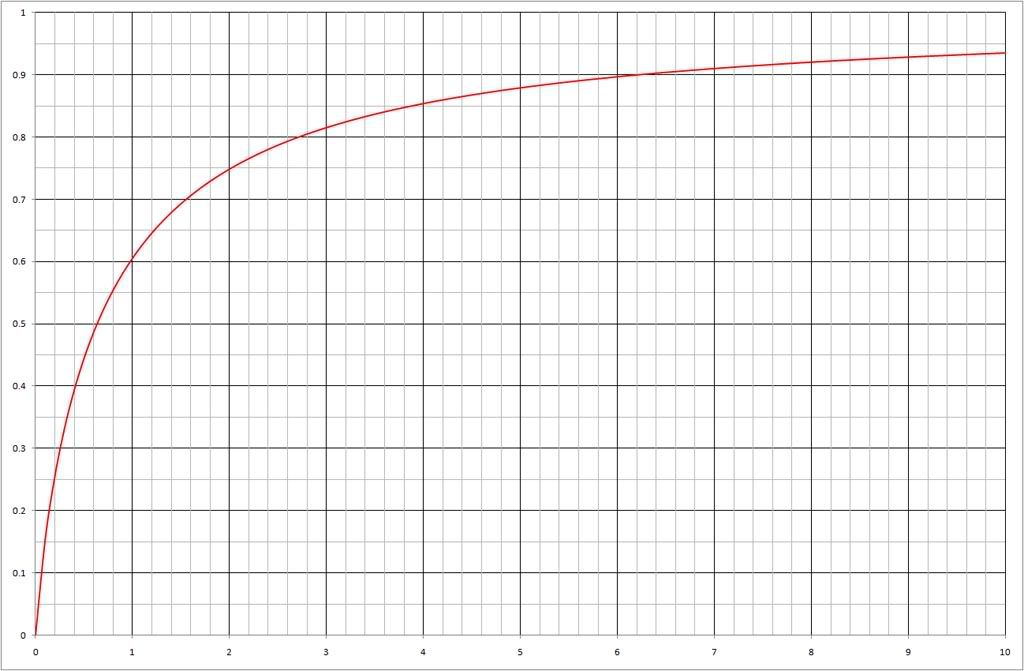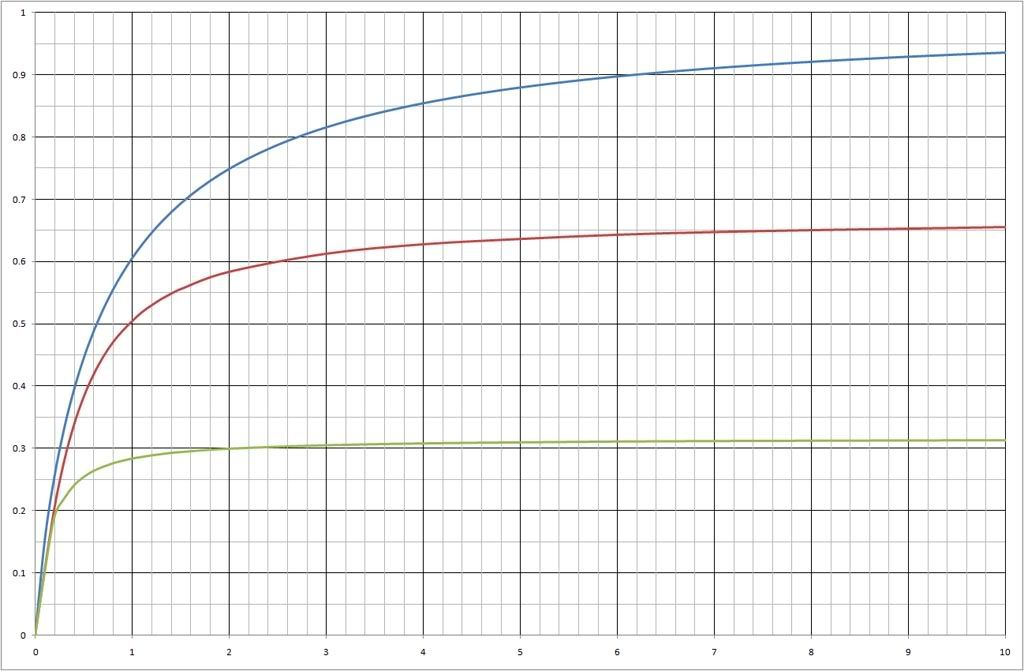How big should I make the air tank?
-
Sniperking98
- Private

- Posts: 5
- Joined: Thu Oct 22, 2009 8:35 pm
I am currently building a pneumatic potato cannon. It has a manual valve with a five foot long two inch diameter barrel. The cannon will have a six inch diameter air tank. I have ten feet of the six inch pipe and I was wandering how small I should cut the pipe for the air tank to make my cannon work as effectively as possible.
-
cannon monkey
- Specialist 3

- Posts: 399
- Joined: Sun Sep 07, 2008 10:50 am
- Location: usa FL
for a pneumatic make the barrel and chamber 1:1 barrel to chamber
or 1:2 barrel to chamber
just do the math find out the volume
or 1:2 barrel to chamber
just do the math find out the volume
- spudtyrrant
- Corporal


- Posts: 550
- Joined: Fri Jan 02, 2009 6:10 pm
note he said a manual valve(ball valve) so for it to be as effective as possible he would need a 2:1 C:B ratio(a 1:1 ratio is only for highly efficient valves) which would mean his air tank needs to be right about 15 inches long anything over that and you would not notice an increase in powercannon monkey wrote:for a pneumatic make the barrel and chamber 1:1 barrel to chamber
or 1:2 barrel to chamber
just do the math find out the volume
-
Sniperking98
- Private

- Posts: 5
- Joined: Thu Oct 22, 2009 8:35 pm
So if I made the air tank larger than 15 inches why wouldn't the cannon have more power?
Last edited by Sniperking98 on Thu Oct 22, 2009 10:12 pm, edited 1 time in total.
- D_Hall
- Staff Sergeant 5


- Posts: 1944
- Joined: Thu Feb 07, 2008 7:37 pm
- Location: SoCal
- Has thanked: 11 times
- Been thanked: 44 times
Law of diminishing returns. Technically speaking you WOULD get more power, the question is... How much?Sniperking98 wrote:So if I made the the air tank larger than 15 inches why wouldn't the cannon have more power?
For each inch of chamber length, you will get a muzzle velocity increase, but that increase will get smaller and smaller. At some point you'll find that the additional increase in velocity associated with making a chamber longer just isn't worth the extra resources required to haul around and fill up that chamber. I mean, do you really care if your muzzle velocity is 500 fps vs. 495 fps? Would you go through twice as much work pumping up a chamber for that extra 5 fps?
So.... Where exactly does the additional velocity given by another inch of chamber not become worth it? That's a matter of debate and it depends upon the resources you have at hand, the size of the gun, etc. But I think everybody agrees that the tipping point is somewhere between a 2:1 chamber/barrel ratio and a 4:1 chamber/barrel ratio.
- Technician1002
- Captain

- Posts: 5189
- Joined: Sat Apr 04, 2009 11:10 am
Please note that effective varies with operating pressure.
Low pressure needs more chamber volume to keep up the pressure in the barrel as the air expands. At high pressure the volume needed is less as the gas in the chamber will expand more when fired. This is the reason I can get a 2 shirt out a 2.5 inch barrel into the stands at a concert, but can't get a golf ball out a 1.7 inch ID barrel at 8 PSI on the marshmallow cannon. The ball moves, but doesn't exit. With a larger tank the ball launches very well at 8 PSI.
Low pressure needs more chamber volume to keep up the pressure in the barrel as the air expands. At high pressure the volume needed is less as the gas in the chamber will expand more when fired. This is the reason I can get a 2 shirt out a 2.5 inch barrel into the stands at a concert, but can't get a golf ball out a 1.7 inch ID barrel at 8 PSI on the marshmallow cannon. The ball moves, but doesn't exit. With a larger tank the ball launches very well at 8 PSI.
Seriously, where does this misinformation come from?spudtyrrant wrote:note he said a manual valve(ball valve) so for it to be as effective as possible he would need a 2:1 C:B ratio(a 1:1 ratio is only for highly efficient valves)
You're the wrong way around. Only the more efficient valves can actually make (much) use of the extra chamber volume.
The slower valves let so little air through in the time available that a larger chamber volume is pure waste.
Not myself. Most of the time, I would suggest 2:1 is at the upper end of what you should use.D_Hall wrote:But I think everybody agrees that the tipping point is somewhere between a 2:1 chamber/barrel ratio and a 4:1 chamber/barrel ratio.
A while back, I did a whole load of integrals for C:B ratios. That table is here:

However, the table is misleading, because it assumes perfect valve flow. Without perfect valve flow, an increase in velocity causes loss of efficiency. So, to illustrate this theoretical performance versus real life, I've added two further curves:

The blue one is the theoretical performance.
The maroon one is simulations of HEAL's performance (with appropriate chamber size) using a 20 gram projectile.
The green one is simulations of HEAL's performance with half the valve diameter (to demonstrate the point I make above to spudtyrrant).
The difference between theoretical and actual performance is obvious - lower performance, and those diminishing returns hit sooner.
The difference between a top end valve and what is still a pretty decent valve (it would outstrip a ball valve) is also obvious - lower performance, and those diminishing returns hit sooner.
If I modelled it with an even lesser valve, it would demonstrate a tendency for an even lesser "ideal" C:B ratio.
If we assume that the "ideal" C:B ratio is the one at which the cannon achieves 90% of the energy it could with an infinite C:B ratio, then HEAL has an ideal C:B of about 2.15:1 with its normal valve (For reference, the normal ratio is pretty much 1.5:1). That falls to about 1:1 with the half diameter valve.
My point about lesser valves having lower ideal C:B ratios stands. Ball valve cannons aren't really able to justify a 2:1 C:B ratio over a straight 1:1, because they can't use that extra volume.
Anyway, to get back to the point, I'd normally waver between 0.5:1 and 2:1. It depends on the cannon.
Does that thing kinda look like a big cat to you?
- spudtyrrant
- Corporal


- Posts: 550
- Joined: Fri Jan 02, 2009 6:10 pm
well rag..... as d_hall said it has to do with the Law of diminishing returns, i modeled a ball valve cannon to my best ability(burst disk with 15% efficiency) and it says with those stats you will get about a 20% gain in fps with a 2:1 over a 1:1 so if he has an air compressor, why not do it?
If he has a bike pump or small compressor it might be in his best interest to go with a smaller chamber for ease of use.
If he has a bike pump or small compressor it might be in his best interest to go with a smaller chamber for ease of use.
With those stats, it's meaningless. I wouldn't take any modelling of a ball valve as if it were a burst disk seriously, and even less so at that efficiency.spudtyrrant wrote:I modelled a ball valve cannon to my best ability(burst disk with 15% efficiency) and it says with those stats...
If you insist on modelling a ball valve with a burst disk's opening time, you'd be talking valve efficiencies of about 2 to 5%, and that's probably generous.
Bloody unlikely, unless there's something major and unseen at play. The increase in theoretical velocity under those circumstances for a valve with perfect flow (not even accounting for loss in pressure due to flow velocity, or external air pressure) is ~11%. Increase on any actual test would probably (depending on criteria) be less.You will get about a 20% gain in fps with a 2:1 over a 1:1
If you're seeing much more than about a 10% velocity increase from 1:1 up to 2:1 with a really serious valve, you're almost certainly mistaken. If you're seeing it with a ball valve, you've broken the universe.
~~~~~
It's simple logic. While a bigger chamber keeps average chamber pressure during decompression, that higher average chamber pressure only makes a difference if the valve can meaningfully shift it through into the barrel and behind the projectile.
Ball valves aren't good enough to do that. Flow on a ball valve is so low, the pressure in the chamber doesn't drop much anyway, even with a low C:B. Why waste time and resources to try and lower chamber pressure drop when it's already low?
I can't stress the fact enough. Large C:B ratios are a major waste of resources unless there is a valve that can handle enough air to make use of more.
With a ball valve cannon, you won't notice the difference between 1:1 and 2:1 - you'd struggle to work it out with a chrony.
EDIT: Spelling.
Last edited by Ragnarok on Fri Oct 23, 2009 11:48 am, edited 2 times in total.
Does that thing kinda look like a big cat to you?
- Technician1002
- Captain

- Posts: 5189
- Joined: Sat Apr 04, 2009 11:10 am
After hand pumping up a couple of my cannons, the difference between filling the little one and the huge one is tremendous. In launching t shirts the little one gets 200 feet at 80 PSI and the large one gets 200 feet at 30 PSI. It is much easier to fill the little one quickly with a hand pump.spudtyrrant wrote:well rag..... as d_hall said it has to do with the Law of diminishing returns, i modeled a ball valve cannon to my best ability(burst disk with 15% efficiency) and it says with those stats you will get about a 20% gain in fps with a 2:1 over a 1:1 so if he has an air compressor, why not do it?
If he has a bike pump or small compressor it might be in his best interest to go with a smaller chamber for ease of use.
